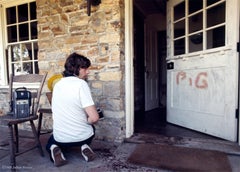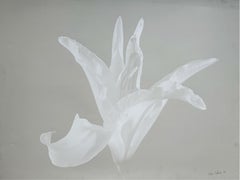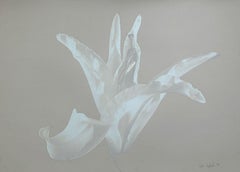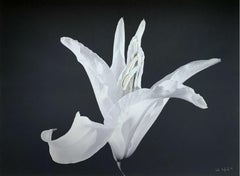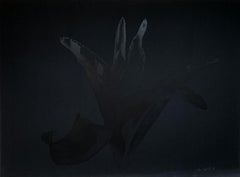Roman Polanski
„Rosemary’s Baby“ Vintage American Lobby Card of the Movie, USA 1968.
Located in Cologne, DE
Vintage American Lobby Card of the Movie „Rosemary’s Baby“ USA 1968 Director: Roman Polanski
Category
1960s Modern More Art
Materials
Offset
$711
H 11.03 in W 13.94 in
Roman Polanksi on Cielo Drive
By Julian Wasser
Located in Chicago, IL
Roman Polanski on Cielo Drive, LIFE Magazine, 1969
Silver Gelatin Print
Edition size: 15
16 x 20
Category
21st Century and Contemporary Contemporary Color Photography
Materials
Silver Gelatin
Original "Spoleto 1974, Lulu Opera' vintage poster
By Richard Lindner
Located in Spokane, WA
Original linen-backed 1974 Spoleto poster. Roman Polanski directed Alban Berg's opera LuLu at the
Category
1970s Abstract Figurative Prints
Materials
Lithograph
$799 Sale Price
20% Off
H 41 in W 39.5 in D 0.05 in
A lily. Photo on matte paper, Still life, Floral, Monochromatic, Polish artist
Located in Warsaw, PL
, Jerzy Kosiński, Richard Nixon, Luciano Pavarotti, Roman Polański, Andy Warhol.
Czesław Czapliński’s
Category
1990s Contemporary Still-life Photography
Materials
Paper
A lily. Photo on matte paper, Still life, Floral, Monochromatic, Polish artist
Located in Warsaw, PL
, Jerzy Kosiński, Richard Nixon, Luciano Pavarotti, Roman Polański, Andy Warhol.
Czesław Czapliński’s
Category
1990s Contemporary Still-life Photography
Materials
Paper
A lily. Photo on matte paper, Still life, Floral, Blue and grey, Polish artist
Located in Warsaw, PL
, Jerzy Kosiński, Richard Nixon, Luciano Pavarotti, Roman Polański, Andy Warhol.
Czesław Czapliński’s
Category
1990s Contemporary Still-life Photography
Materials
Paper
A lily. Photo on matte paper, Still life, Floral, Black & White, Polish artist
Located in Warsaw, PL
, Jerzy Kosiński, Richard Nixon, Luciano Pavarotti, Roman Polański, Andy Warhol.
Czesław Czapliński’s
Category
1990s Contemporary Still-life Photography
Materials
Paper
A lily. Photo on matte paper, Still life, Floral, Monochromatic, Polish artist
Located in Warsaw, PL
, Jerzy Kosiński, Richard Nixon, Luciano Pavarotti, Roman Polański, Andy Warhol.
Czesław Czapliński’s
Category
1990s Contemporary Still-life Photography
Materials
Paper
PANIQUE Signed Lithograph, Surreal Caricature Portrait, Black Humor
By Roland Topor
Located in Union City, NJ
, hazard and euphoria. Topor wrote the novel "The Tenant" (1964), which was filmed by Roman Polanski as The
Category
1970s Surrealist Portrait Prints
Materials
Lithograph
$810
H 26 in W 19.75 in
Nouvelles En Trois Lignes I
By Roland Topor
Located in San Francisco, CA
Jodorowsky and Fernando Arrabal. Topor wrote the novel "The Tenant" (1964), which was filmed by Roman
Category
Late 20th Century Surrealist Figurative Prints
Materials
Lithograph
Nouvelles En Trois Lignes IV
By Roland Topor
Located in San Francisco, CA
Jodorowsky and Fernando Arrabal. Topor wrote the novel "The Tenant" (1964), which was filmed by Roman
Category
Late 20th Century Surrealist Figurative Prints
Materials
Lithograph
Nouvelles En Trois Lignes III
By Roland Topor
Located in San Francisco, CA
Jodorowsky and Fernando Arrabal. Topor wrote the novel "The Tenant" (1964), which was filmed by Roman
Category
Late 20th Century Surrealist Figurative Prints
Materials
Lithograph
Large Venezuelan Expressionist Oil Painting Diego Barboza Latin American Master
Located in Surfside, FL
Moorman, and Roman Polanski would gather there. Venezuela, especially Caracas, was a rich field of action
Category
1980s Neo-Expressionist Figurative Paintings
Materials
Canvas, Oil
$12,500
H 57.5 in W 36.75 in
Recent Sales
Roman Polanski Closeup Fine Art Print
By Bill Bridges
Located in Las Vegas, NV
, Roman Polanski. This captivating image features the director closeup, looking away from the camera to
Category
1960s Color Photography
Materials
Archival Ink, Archival Paper, C Print, Archival Pigment
Roman Polanski: Legendary Film Director Fine Art Print
By Bill Bridges
Located in Las Vegas, NV
, Roman Polanski. This captivating image features the director looking away from the camera outdoors
Category
1960s Color Photography
Materials
Archival Ink, Archival Paper, C Print, Archival Pigment
Sharon Tate in Bikini Fine Art Print
Located in Las Vegas, NV
Sharon Tate was a 1960's model and actress who was married to Roman Polanski. On August 9, 1969
Category
1960s Black and White Photography
Materials
Archival Ink, Archival Paper, Archival Pigment
Sharon Tate Up Close Fine Art Print
Located in Las Vegas, NV
model and actress who was married to Roman Polanski. On August 9, 1969 she was murdered by the Manson
Category
1960s Color Photography
Materials
Archival Ink, Archival Paper, Archival Pigment
Mia Farrow Lying on Beach Fine Art Print
By Larry Barbier
Located in Las Vegas, NV
recognition for her subsequent short-lived marriage to Frank Sinatra. An early film role, as Rosemary in Roman
Category
1960s Color Photography
Materials
Archival Ink, Archival Paper, C Print, Archival Pigment
Mia Farrow: Young Star Actress Fine Art Print
Located in Las Vegas, NV
film role, as Rosemary in Roman Polanski's Rosemary's Baby (1968), saw her nominated for a BAFTA Award
Category
1960s Color Photography
Materials
Archival Ink, Archival Paper, C Print, Archival Pigment
Candid Sharon Tate in Italy Fine Art Print
By Araldo di Crollalanza
Located in Las Vegas, NV
1968 while in London, Tate married Roman Polanski, her director and costar in The Fearless Vampire
Category
1960s Black and White Photography
Materials
Archival Ink, Archival Paper, Archival Pigment
PURE EVIL: Roman Polanski's nightmare, unique hand finished print. Sharon Tate
By Pure Evil
Located in Madrid, Madrid
Roman Polanski's nightmare - Bubble letters never die
Date of creation: 2017
Medium: Hand finished
Category
2010s Pop Art Figurative Prints
Materials
Ink, Spray Paint, Screen, Stencil
Untitled (Brody)
By Adrien Brody
Located in New York, NY
recognition and acclaim after starring in Roman Polanski's The Pianist, for which he won the Academy Award for
Category
2010s Contemporary Abstract Paintings
Materials
Canvas, Mixed Media, Oil
La Rapita - Spay on Paper by R. Topor - 1981
By Roland Topor
Located in Roma, IT
chimérique, 1964), which was adapted to film by Roman Polanski in 1976. With René Laloux, Topor made "The
Category
1980s Contemporary Figurative Paintings
Materials
Spray Paint
Untitled - Spay on Paper by R. Topor - 1983
By Roland Topor
Located in Roma, IT
The Tenant (Le Locataire chimérique, 1964), which was adapted to film by Roman Polanski in 1976. With
Category
1980s Contemporary Figurative Paintings
Materials
Spray Paint
L'ESCALIER Signed Lithograph, Surrealist Portrait, Black Humor, Stairs
By Roland Topor
Located in Union City, NJ
euphoria. Topor wrote the novel "The Tenant" (1964), which was filmed by Roman Polanski as The Tenant (1976
Category
1970s Surrealist Portrait Prints
Materials
Lithograph
COUP DE VENT(Gust Of Wind) Signed Lithograph, Surreal Portrait, Black Humor
By Roland Topor
Located in Union City, NJ
Tenant" (1964), which was filmed by Roman Polanski as The Tenant (1976) (a remake of the film, Le nouveau
Category
1970s Surrealist Portrait Prints
Materials
Lithograph
PURE EVIL: ROMAN POLANSKI'S NIGHTMARE - SHARON TATE Unique Street Pop Art
By Pure Evil
Located in Madrid, Madrid
ROMAN POLANSKI'S NIGHTMARE - SHARON TATE
Date of creation: 2020
Medium: Hand finished screen print
Category
2010s Pop Art Figurative Prints
Materials
Ink, Spray Paint, Screen, Stencil
PURE EVIL: Roman Polanski's nightmare. Sharon Tate. Limited ed. Screen print
By Pure Evil
Located in Madrid, Madrid
Roman Polanski's Nightmare - Sharon Tate - Danger Colours
Date of creation: 2017
Medium: Screen
Category
2010s Pop Art Figurative Prints
Materials
Screen
Richard Avedon-Nastassja Kinski and the Serpent-24.5" x 35.75"-Poster-1981
By Richard Avedon
Located in Brooklyn, NY
both through her active acting career, as well as through her relationship with Roman Polanski at the
Category
20th Century Prints and Multiples
Materials
Offset
The Dakota (Used in Rosemary's Baby and the scene where John Lennon was killed)
By Frederick Mershimer
Located in New Orleans, LA
featured in the movie Rosemarys Baby by Roman Polanski. Lauren Bacall, Judy Garland and Leonard Bernstein
Category
Early 2000s American Modern Landscape Prints
Materials
Mezzotint, Aquatint
Nouvelles En Trois Lignes V
By Roland Topor
Located in San Francisco, CA
Jodorowsky and Fernando Arrabal. Topor wrote the novel "The Tenant" (1964), which was filmed by Roman
Category
Late 20th Century Surrealist Figurative Prints
Materials
Lithograph
Nouvelles En Trois Lignes II
By Roland Topor
Located in San Francisco, CA
Jodorowsky and Fernando Arrabal. Topor wrote the novel "The Tenant" (1964), which was filmed by Roman
Category
Late 20th Century Surrealist Figurative Prints
Materials
Lithograph
Get Updated with New Arrivals
Save "Roman Polanski", and we’ll notify you when there are new listings in this category.
Roman Polanski For Sale on 1stDibs
Find the exact roman polanski you’re shopping for in the variety available on 1stDibs. You can easily find an example made in the contemporary style, while we also have 3 contemporary versions to choose from as well. If you’re looking for a roman polanski from a specific time period, our collection is diverse and broad-ranging, and you’ll find at least one that dates back to the 20th Century while another version may have been produced as recently as the 21st Century. When looking for the right roman polanski for your space, you can search on 1stDibs by color — popular works were created in bold and neutral palettes with elements of gray, black and beige. Finding an appealing roman polanski — no matter the origin — is easy, but Roland Topor, Herb Ritts, Horst P. Horst, Caleb Martin and Frederick Mershimer each produced popular versions that are worth a look. Frequently made by artists working in lithograph, paint and acrylic paint, these artworks are unique and have attracted attention over the years. If space is limited, you can find a small roman polanski measuring 6.94 high and 9.5 wide, while our inventory also includes works up to 36.75 across to better suit those in the market for a large roman polanski.
How Much is a Roman Polanski?
The average selling price for a roman polanski we offer is $1,000, while they’re typically $350 on the low end and $12,500 for the highest priced.
More Ways To Browse
Lobby Card
Vintage Illusion Dress
Art Nouveau Male
Vintage Animation Posters
Henri Iv
Vintage Calvin Klein
Oscar De La Renta 1999
Fendi Prints On
Scottish Art Nouveau
Calvin Klein 1989
Calvin Klein 1999
Sombrero Vintage
Fendi 1974
Vampire Vintage Art
Oscar De La Renta 2005
Grey Crawford
Nastassja Kinski
Jean Colonna
